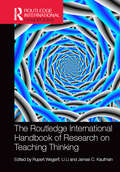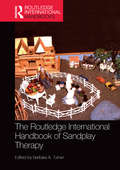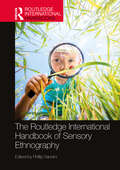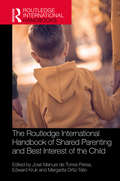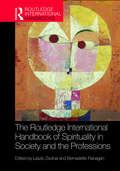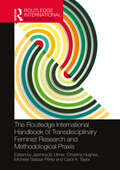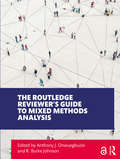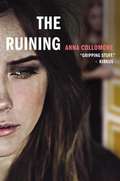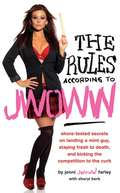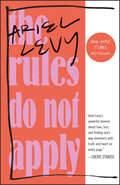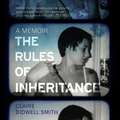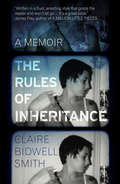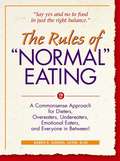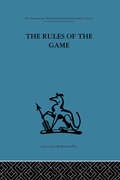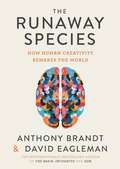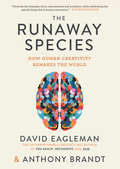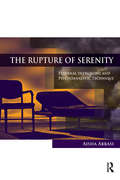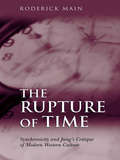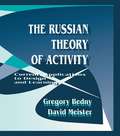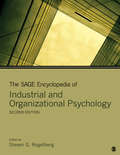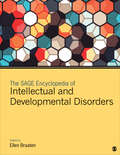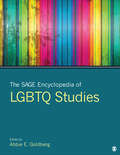- Table View
- List View
The Routledge International Handbook of Research on Teaching Thinking (Routledge International Handbooks of Education)
by James C. Kaufman Li Li Rupert WegerifThe Routledge International Handbook of Research on Teaching Thinking is a comprehensive guide to research on teaching thinking. Teaching thinking is key to growing a more successful economy, is needed for increased democratic engagement and is vital for the well-being of individuals faced with the complexity of a globalised world. However, there are questions about what we mean by ‘thinking’, how best to teach it and how best to assess it, and it is these questions that this handbook explores and addresses. Containing surveys and summaries of international, cutting-edge research on every aspect of teaching thinking in a range of contexts, the handbook is thorough in its delivery, examining many different approaches and methods to help readers understand what teaching thinking is and how we can best take this movement forward. Key topics include: • Theoretical perspectives on teaching thinking • Approaches for teaching thinking • Developing creative thinking • Developing critical thinking and metacognition • The assessment of thinking • Teaching thinking in the context of STEM • Collaborative thinking and new technology • Neuro-educational research on teaching thinking This book is an essential guide for policy-makers, teachers and researchers who are interested in teaching thinking
The Routledge International Handbook of Sandplay Therapy (Routledge International Handbooks)
by Barbara A. TurnerThe Routledge International Handbook of Sandplay Therapy provides a comprehensive overview of this therapeutic method, developed to provide a means of helping clients of all ages with mental suffering. The contributors, from a range of therapeutic and cultural backgrounds, demonstrate core theory and practice, and explore the implications of current neuroscientific research. The chapters illustrate the effectiveness of this seemingly simple psychotherapeutic tool in its contemporary applications. Split into six parts, this handbook considers: Sandplay therapy in medicine Sandplay with special populations Sandplay in analysis and general practice Adaptions of the Sandplay method in education Sandplay and the spirit Non-Jungian uses of the sand tray in therapeutic applications Unique in scope and breadth, this handbook will appeal to academics and students of Jungian psychotherapy, as well as occupational therapists, art and play therapists, and all clinicians using Sandplay therapy as part of their professional practice.
The Routledge International Handbook of Sensory Ethnography (Routledge International Handbooks)
by Phillip VanniniThe Routledge International Handbook of Sensory Ethnography reviews and expands the field and scope of sensory ethnography by fostering new links among sensory, affective, more-than-human, non-representational, and multimodal sensory research traditions and composition styles. From writing and film to performance and sonic documentation, the handbook reimagines the boundaries of sensory ethnography and posits new possibilities for scholarship conducted through the senses and for the senses. Sensory ethnography is a transdisciplinary research methodology focused on the significance of all the senses in perceiving, creating, and conveying meaning. Drawing from a wide variety of strategies that involve the senses as a means of inquiry, objects of study, and forms of expression, sensory ethnography has played a fundamental role in the contemporary evolution of ethnography writ large as a reflexive, embodied, situated, and multimodal form of scholarship. The handbook dwells on subjects like the genealogy of sensory ethnography, the implications of race in ethnographic inquiry, opening up ethnographic practice to simulate the future, using participatory sensory ethnography for disability studies, the untapped potential of digital touch, and much more. This is the most definitive reference text available on the market and is intended for advanced undergraduates, graduate students, and researchers in anthropology, sociology, and the social sciences, and will serve as a state-of-the-art resource for sensory ethnographers worldwide.
The Routledge International Handbook of Shared Parenting and Best Interest of the Child
by José ManuelThis multidisciplinary volume offers an essential, comprehensive study of perspectives on the scope and application of the best interests of the child and focuses mainly on its application in relation to child custody. With expert contributions from psychological, sociological and legal perspectives, it offers scientific analysis and debate on whether it should be the primary consideration in deciding child custody cases in cases of divorce or separation or whether it should be one of several primary considerations. It explores complex dilemmas inherent in shared parenting and whether the advantages it offers children are sufficient when compared to attributing custody to one parent and limiting visitation rights of the other. Offering a comprehensive analysis of this complex topic, chapters provide detailed insight into the current state of research in this area, as well as expert guidelines aimed at resolving the controversies when parents agree or disagree over their children’s living arrangements. Cutting-edge topics explored include: transnational shared parenting; alternative dispute resolution; breastfeeding parents; religious disputes between parents and the psychological, social and economic factors that affect shared parenting. The Routledge International Handbook of Shared Parenting and Best Interest of the Child will be essential reading for scholars and graduate students in law, psychology, sociology and economics interested in shared parenting and family law.
The Routledge International Handbook of Spirituality in Society and the Professions (Routledge International Handbooks)
by Laszlo Zsolnai Bernadette FlanaganIncreasingly, it is being recognized that spirituality, defined here as "a multiform search for a transcendent meaning of life that connects them to all living beings and brings them in touch with God or ‘Ultimate Reality,’" is an aspect of almost every sphere and aspect of social life. It appears in humanity’s dealings with nature, home and community, healing, economics and business, knowledge, and education. The Routledge International Handbook of Spirituality in Society and the Professions is a stimulating collection that summarizes the most important issues, frameworks, discussions, and problems relating to spiritually inspired activities in different fields of social life. The contributors explore how spirituality is a part of existence and present approaches and models for professionals working in diverse areas. Presented in seven parts, the book provides a full overview of current research and practice. Part II, "Facets of spirituality," explores topics including philosophy, psychology, theology, and culture. Part III, "Nature," looks at ecology, agriculture, cities, and tourism. Part IV, "Home and community," presents chapters on various life stages, disability, gender, and culture. Part V, "Healing," examines medicine, mental and physical health, and ill-health. In Part VI, "Economy, politics, and law," contributors discuss business, leadership and the workplace, peace, and policing. Part VII, "Knowledge and education," includes chapters on science, design, fashion, literature, and the arts. In the final part, "Way forward," the editors look to the future with a chapter on inter-spirituality and the renewal of social practices. Driven by contemporary research and new developments, this Handbook is an innovative and interdisciplinary collection that provides an essential overview of contemporary spirituality and society from an international selection of contributors. The Routledge International Handbook of Spirituality in Society and the Professions offers accessible, diverse, and engaging international research, and its scope will appeal to academics and students of a wide range of subjects, including aging and addiction, psychology, theology, religious studies, sociology, business studies, and philosophy. It will also be an important work for professionals in medical and social services, the clergy, education, business, the arts, religious communities, and politics, and members of organizations looking at the links between spirituality, religion, and society.
The Routledge International Handbook of Transdisciplinary Feminist Research and Methodological Praxis
by Carol A. Taylor Christina Hughes Michelle Salazar Pérez Jasmine B. UlmerThe Routledge International Handbook of Transdisciplinary Feminist Research and Methodological Praxis is organized around ways of doing fair and just research, with deliberate transdisciplinary overlap in each of the sections so as to share and demonstrate potential opportunities for lasting alliances.Authors and artists address topics that include the doing of original transdisciplinary research and engaging multiple communities in research; mentoring from both academic and community-based perspectives; creating and maintaining collaborative relationships; managing personal, professional, and financial challenges; addressing writing blocks and feelings of being overwhelmed; and experiences of care and joy. The range of feminist work invoked in this volume include, but are not limited to: intersectional feminisms, abolitionist feminism, Black feminism, Womanism, Chicana feminism, Latina feminism, BIPOC feminisms, Indigenous feminism, decolonial and postcolonial feminism, transnational feminism, gender and sexuality studies, queer feminism, trans feminisms, poststructural feminism, posthuman and more-than-human feminism, materialist feminism, crip feminism, feminist disability studies, quantum feminism, sonic feminisms, feminist science studies, science and technology studies, or STS, and more.From advanced graduate students to seasoned scholars, this volume presents timely knowledge and will be useful as a substantive guide to round out understandings of multiple approaches to feminist research.
The Routledge International Handbook of the Psychology of Morality (Routledge International Handbooks)
by Naomi Ellemers Stefano Pagliaro Félice Van NunspeetThis cutting-edge handbook examines moral psychology and behavior, uncovering layers of human morality through a comprehensive overview of topics and approaches. Featuring an array of expert international contributors, the book addresses five key themes: moral reasoning, moral judgments, moral emotions, moral behavior and moral self-views. Each section includes empirical chapters that address these themes at the intrapersonal, interpersonal, intragroup or intergroup level. Each section starts with a reflective chapter from a leading scholar in this field of study who shares their personal vision on key issues and future developments. Drawing on emerging research and featuring real-world examples, the book offers a deeper understanding of the social psychological factors that shape our moral behavior and how this plays out in our daily lives. The Routledge International Handbook of the Psychology of Morality will be essential reading for academics and students in social psychology, the psychology of morality, business ethics and related areas. It will also be a compelling resource for legal and HR professionals, policy makers and anyone interested in understanding the complex and multi-faceted nature of human morality.
The Routledge Reviewer’s Guide to Mixed Methods Analysis
by Anthony J. Onwuegbuzie R. Burke JohnsonThe Routledge Reviewer’s Guide to Mixed Methods Analysis is a groundbreaking edited book – the first devoted solely to mixed methods research analyses, or mixed analyses. Each of the 30 seminal chapters, authored by internationally renowned scholars, provides a simple and practical introduction to a method of mixed analysis. Each chapter demonstrates "how to conduct the analysis" in easy-to-understand language. Many of the chapters present new topics that have never been written before, and all chapters offer cutting-edge approaches to analysis. The book contains the following four sections: Part I Quantitative Approaches to Qualitative Data (e.g., factor analysis of text, multidimensional scaling of qualitative data); Part II Qualitative Approaches to Quantitative Data (e.g., qualitizing data, mixed methodological discourse analysis); Part III "Inherently" Mixed Analysis Approaches (e.g., qualitative comparative analysis, mixed methods social network analysis, social media analytics as mixed analysis, GIS as mixed analysis); and Part IV Use of Software for Mixed Data Analysis (e.g., QDA Miner, WordStat, MAXQDA, NVivo, SPSS). The audience for this book includes (a) researchers, evaluators, and practitioners who conduct a variety of research projects and who are interested in using innovative analyses that will allow them to extract more from their data; (b) academics, including faculty who would use this book in their scholarship, as well as in their graduate-level courses, and graduate students who need access to a comprehensive set of mixed analysis tools for their dissertations/theses and other research assignments and projects; and (c) computer-assisted data analysis software developers who are seeking additional mixed analyses to include within their software programs. Chapter 24 of this book is freely available as a downloadable Open Access PDF at http://www.taylorfrancis.com under a Creative Commons Attribution-Non Commercial-No Derivatives (CC-BY-NC-ND) 4.0 license.
The Ruining
by Anna CollomoreAnnie Phillips is thrilled to leave her past behind and begin a shiny new life on Belvedere Island, as a nanny for the picture-perfect Cohen family. In no time at all, she falls in love with the Cohens, especially with Libby, the beautiful young matriarch of the family. Life is better than she ever imagined. She even finds romance with the boy next door. All too soon, cracks appear in Annie's seemingly perfect world. She's blamed for mistakes she doesn't remember making. Her bedroom door comes unhinged, and she feels like she's always being watched. Libby, who once felt like a big sister, is suddenly cold and unforgiving. As she struggles to keep up with the demands of her new life, Annie's fear gives way to frightening hallucinations. Is she tumbling into madness, or is something sinister at play? The Ruining is a complex ride through first love, chilling manipulation, and the terrifying depths of insanity.
The Rules According to JWOWW: Shore-Tested Secrets on Landing a Mint Guy, Staying Fresh to Death, and Kicking the Competition to the Curb
by Sheryl Berk Jenni "JWOWW" FarleyOne of the stars of MTV’s smash hit series The Jersey Shore, Jennifer “JWOWW” Farley lays down The Rules According to JWOWW, offering a new spin on the dos and don’ts of dating, from “smushing” guys to avoiding booty calls to finding the guy of your dreams. The book includes empowering advice for a new generation of self-assured young women, as JWOWW shares her “shore-tested secrets on landing a mint guy, staying fresh to death, and kicking the competition to the curb.”
The Rules Do Not Apply: A Memoir
by Ariel LevyA gorgeous memoir about a woman overcoming dramatic loss and finding reinvention—for readers of Cheryl Strayed and Joan Didion When thirty-eight-year-old New Yorker writer Ariel Levy left for a reporting trip to Mongolia in 2012, she was pregnant, married, financially secure, and successful on her own terms. A month later, none of that was true. Levy picks you up and hurls you through the story of how she built an unconventional life and then watched it fall apart with astonishing speed. Like much of her generation, she was raised to resist traditional rules—about work, about love, and about womanhood. “I wanted what we all want: everything. We want a mate who feels like family and a lover who is exotic, surprising. We want to be youthful adventurers and middle-aged mothers. We want intimacy and autonomy, safety and stimulation, reassurance and novelty, coziness and thrills. But we can’t have it all.” In this profound and beautiful memoir, Levy chronicles the adventure and heartbreak of being “a woman who is free to do whatever she chooses.” Her own story of resilience becomes an unforgettable portrait of the shifting forces in our culture, of what has changed—and of what is eternal. Advance praise for The Rules Do Not Apply“I read The Rules Do Not Apply in one long, rapt sitting. Unflinching and intimate, wrenching and revelatory, Ariel Levy’s powerful memoir about love, loss, and finding one’s way shimmers with truth and heart on every page.”—Cheryl Strayed “Every deep feeling a human is capable of will be shaken loose by this profound book. Ariel Levy has taken grief and made art out of it.”—David Sedaris “Ariel Levy is a writer of uncompromising honesty, remarkable clarity, and surprising humor gathered from the wreckage of tragedy. Her account of life doing its darnedest to topple her, and her refusal to be knocked down, will leave you shaken and inspired. I am the better for having read this book.”—Lena Dunham “A great memoir is not a trip through someone else’s life but a series of long looks into your own. Ariel Levy’s book—grieving, hopeful, painful, funny—is that.”—Amy Bloom “It’s become a truism that feminists are living out our mothers’ unlived lives. But Ariel Levy seems to be living out the unlived lives of an entire generation of women, simultaneously. Free to do whatever she chooses, she chooses everything. While reinventing work, marriage, family, pregnancy, sex, and divorce for herself from the ground up, Levy experiences devastating loss. And she recounts it all here with searing intimacy and an unsentimental yet openhearted rigor.”—Alison Bechdel “The Rules Do Not Apply is heartbreaking, brilliant, and disarming, the kind of book that may change you. Ariel Levy writes with a beauty that is ferociously honest and with the fervor of an explorer. No one else has written so insightfully about the current legacy of feminism’s ‘lavish gift’ of freedom. Levy has a voice unlike any other. This is a devastating and inspired book.”—René Steinke
The Rules of Inheritance
by Claire Bidwell SmithIn this astonishing debut, Claire Bidwell Smith, an only child, is just fourteen years old when both of her charismatic parents are diagnosed with cancer. What follows is a coming-of-age story that is both heartbreaking and exhilarating. As Claire hurtles towards loss she throws herself at anything she thinks might help her cope with the weight of this harsh reality: boys, alcohol, traveling, and the anonymity of cities like New York and Los Angeles. By the time she is twenty-five years old they are both gone and Claire is very much alone in the world. Claire's story is less of a tragic tale and more of a remarkable lesson on how to overcome some of life's greatest hardships. Written with suspense and style, and bursting with love and adventure, The Rules of Inheritance vividly captures the deep grief and surprising light of a young woman forging ahead on a journey of loss that humbled, strengthened, and ultimately healed her.(P)2013 Headline Digital
The Rules of Inheritance: A Memoir
by Claire Bidwell SmithClaire Bidwell Smith, an only child, is just fourteen years old when both of her charismatic parents are diagnosed with cancer. What follows is a coming-of-age story that is both heartbreaking and exhilarating. As Claire hurtles towards loss she throws herself at anything she thinks might help her cope with the weight of this harsh reality: boys, alcohol, traveling, and the anonymity of cities like New York and Los Angeles. By the time she is twenty-five years old both her parents are gone and Claire is very much alone in the world. Claire's story is less of a tragic tale and more of a remarkable lesson on how to overcome some of life's greatest hardships. Written with suspense and style, and bursting with love and adventure, The Rules of Inheritance vividly captures the deep grief and surprising light of a young woman forging ahead on a journey of loss that humbled, strengthened, and ultimately healed her.
The Rules of Normal Eating: A Commonsense Approach for Dieters, Overeaters, Undereaters, Emotional Eaters, and Everyone in Between!
by Karen R. KoenigHere is a book for all eaters who yearn to improve their relationship with food. It gives the answers to what struggling overeaters, undereaters, and chronic dieters all want to know: how to be comfortable around food and find true pleasure in eating. Written in easy-to-understand every day language, The Rules of "Normal" Eating lays out the four basic rules that "normal" eaters follow instinctively-eating when they're hungry, choosing foods that satisfy them, eating with awareness and enjoyment, and stopping when they're full or satisfied. Along with specific skills and techniques which help promote change, The Rules of "Normal" Eating presents a powerful, proven cognitive-behavioral model of transformation that targets beliefs, feelings, and behaviors about food and eating and moves the reader toward genuine physical and emotional fulfillment. Readers will learn how to reprogram their dysfunctional beliefs about food and eating, manage uncomfortable feelings without turning to food, and establish new eating habits that tune their bodies in to natural sensations of hunger, pleasure, satisfaction and satiation. Chocked full of humorous insights, compassion, and practical wisdom gleaned from a therapist and educator who used to diet and binge with the best of them, this book teaches the reader how to think and behave around food the way that "normal" eaters do. The Rules of "Normal" Eating digs deep and addresses how under- and overeaters can overcome the underlying conflicts that often plague and prevent them from becoming "normal" eaters-difficulty sensing what is enough for them, holding onto a mindset of deprivation and self-denial, feeling undeserving of genuine pleasure, and a lack of awareness and skill for effective emotional and physical self-re.
The Rules of the Game: Interdisciplinarity, transdisciplinarity and analytical models in scholarly thought
by Teodor ShaninTavistock Press was established as a co-operative venture between the Tavistock Institute and Routledge & Kegan Paul (RKP) in the 1950s to produce a series of major contributions across the social sciences. This volume is part of a 2001 reissue of a selection of those important works which have since gone out of print, or are difficult to locate. Published by Routledge, 112 volumes in total are being brought together under the name The International Behavioural and Social Sciences Library: Classics from the Tavistock Press. Reproduced here in facsimile, this volume was originally published in 1972 and is available individually. The collection is also available in a number of themed mini-sets of between 5 and 13 volumes, or as a complete collection.
The Runaway Species: How Human Creativity Remakes the World
by Anthony Brandt David EaglemanThe Runaway Species is a deep dive into the creative mind, a celebration of the human spirit, and a vision of how we can improve our future by understanding and embracing our ability to innovate. David Eagleman and Anthony Brandt seek to answer the question: what lies at the heart of humanity’s ability―and drive―to create? <P><P>Our ability to remake our world is unique among all living things. But where does our creativity come from, how does it work, and how can we harness it to improve our lives, schools, businesses, and institutions? <P><P>Eagleman and Brandt examine hundreds of examples of human creativity through dramatic storytelling and stunning images in this beautiful, full-color volume. By drawing out what creative acts have in common and viewing them through the lens of cutting-edge neuroscience, they uncover the essential elements of this critical human ability, and encourage a more creative future for all of us.
The Runaway Species: How human creativity remakes the world
by Anthony Brandt David Eagleman&“The authors look at art and science together to examine how innovations—from Picasso&’s initially offensive paintings to Steve Jobs&’s startling iPhone—build on what already exists and rely on three brain operations: bending, breaking and blending. This manifesto . . . shows how both disciplines foster creativity.&” —The Wall Street JournalThe Runaway Species is a deep dive into the creative mind, a celebration of the human spirit, and a vision of how we can improve our future by understanding and embracing our ability to innovate. David Eagleman and Anthony Brandt seek to answer the question: what lies at the heart of humanity&’s ability—and drive—to create?Our ability to remake our world is unique among all living things. But where does our creativity come from, how does it work, and how can we harness it to improve our lives, schools, businesses, and institutions?Eagleman and Brandt examine hundreds of examples of human creativity through dramatic storytelling and stunning images in this beautiful, full–color volume. By drawing out what creative acts have in common and viewing them through the lens of cutting–edge neuroscience, they uncover the essential elements of this critical human ability, and encourage a more creative future for all of us.&“The Runaway Species approach[es] creativity scientifically but sensitively, feeling its roots without pulling them out.&” —The Economist
The Rupture of Serenity: External Intrusions and Psychoanalytic Technique
by Aisha AbbasiWhat happens when the outside world enters the psychoanalytic space? In The Rupture of Serenity: External Intrusions and Psychoanalytic Technique, the author draws on clinical material to describe some of the dilemmas she has encountered in her work with patients when external factors have entered the treatment frame. She considers analytic dilemmas that range from how to deal with patients' unusual requests regarding the conduct of an analytic treatment to the question of how to handle events in the analyst's personal life that, by necessity, must be addressed in the analysis. As a Muslim of Pakistani origin, the author is also able to discuss, frankly and with compassion, the role that ethnic and religious differences between patient and analyst can play in treatment-differences that, in the aftermath of 9/11 and the search for and killing of Osama bin Laden, became a palpable presence in her consulting room.
The Rupture of Time: Synchronicity and Jung's Critique of Modern Western Culture
by Roderick MainWhy was the idea of synchronicity so important to Jung?Jung's theory of synchronicity radically challenges the entrenched assumptions of mainstream modern culture in the West. It is one of the most fascinating yet difficult and discomfiting of Jung's psychological theories.The Rupture of Time aims to clarify what Jung really meant by synchronicity, why the idea was so important to him and how it informed his thinking about modern western culture. Areas examined include:* how the theory fits into Jung's overall psychological model and the significance of its apparent inconsistencies * the wide range of personal, intellectual and social contexts of Jung's thinking on the topic * how Jung himself applied the theory of synchronicity within his critique of science, religion, and society * the continuing relevance of the theory for understanding issues in contemporary detraditionalised religion. Focusing closely on Jung's own writings and statements, this book discloses that the theory of synchronicity is not an inconsequential addendum to analytical psychology but is central to the psychological project that occupied Jung throughout his professional life. This much-needed clarification of one of Jung's central tenets will be of great interest to all analytical psychologists and scholars engaged with Jungian thought.
The Russian Theory of Activity: Current Applications To Design and Learning (Applied Psychology Series)
by David Meister Gregory BednyThe opening of the former Soviet Union to the West has provided an opportunity to describe Russian human factors/ergonomics and to compare American theories and methods with it. Although this book is principally dedicated to describing the theory of activity as it applies to issues of design and training, it is also offered to a general audience of psychologists and interested lay readers. This theory studies the goal-directed behavior of man and attempts to integrate the cognitive, motivational, and behavioral aspects of activity into a holistic system. Such fundamental notions as goal, action, and self-regulation are described and analyzed from totally different theoretical points of view. This is the first comprehensive, systematic description of the theory of activity in the English language. Existing attempts to translate the theory of activity into English suffer from certain limitations. Among them, the theory of activity -- considered one of the more important accomplishments of Soviet psychological science -- has an extensive history dating back to the work of Vygotsky and his students. Subsequent development of the theory by other well-known Soviet psychologists and psychophysiologists took place within different schools with some significant differences. In the former Soviet Union, psychological theory could not be advanced unconnected to Marxist-Leninist ideology. Accordingly, theoretical formulations were subject to their own version of "political correctness." Books published in this field were addressed only to other scientists with backgrounds in the field. Moreover, the translation of the technical terms in Russian psychology frequently resist translation in the absence of the context of the debates in which they were being used. Thus, simple translation of books in this field as they were written in a specialized and politicized environment for Russian audiences is really not a particularly sensible or worthwhile undertaking. This book is addressed in the first instance to Western psychologists. It compares, among other things, analyses of work from the former Soviet Union with the work from the West. Applications of activity theory to design and learning were paramount in the Soviet Union. Using their own theoretical perspective, the authors provide a comparative analysis of the various schools working in activity theory. They hope that this book may facilitate the exchange of ideas between Russian psychological scientists and Western psychologists working in ergonomics, human factors, industrial/organizational psychology, education, learning, and related areas where the theory of activity may find general application. This book's authors attempt to provide a contribution not only to science but also to history. Western researchers have strongly influenced Russian work, but because of negative political pressure in the former USSR, the flow of concepts was one-sided. Russian ergonomists received so much from American and Western sources that it is now important to give something back. Despite the considerable similarity between Russian and American theories and methods, the special "spin" the former put on their work may stimulate new thinking on the part of their American colleagues.
The SAGE Encyclopedia of Abnormal and Clinical Psychology
by Amy E. WenzelAbnormal and clinical psychology courses are offered in psychology programs at universities worldwide, but the most recent major encyclopedia on the topic was published many years ago. Although general psychology handbooks and encyclopedias include essays on abnormal and clinical psychology, such works do not provide students with an accessible reference for understanding the full scope of the field. The SAGE Encyclopedia of Abnormal and Clinical Psychology, a 7-volume, A-Z work (print and electronic formats), will be such an authoritative work. Its more than 1,400 entries will provide information on fundamental approaches and theories, various mental health disorders, assessment tools and psychotherapeutic interventions, and the social, legal, and cultural frameworks that have contributed to debates in abnormal and clinical psychology. Key features include: 1,400 signed articles contained in 7 volumes and available in choice of print and/or electronic formats although organized A-to-Z, front matter includes a Reader’s Guide grouping related entries thematically back matter includes a Chronology, Resource Guide, Bibliography, and detailed Index entries conclude with References/Further Readings and Cross References to related entries the Index, Reader’s Guide themes, and Cross References between and among entries all combine to provide robust search-and-browse features in the electronic version.
The SAGE Encyclopedia of Industrial and Organizational Psychology
by Steven G. RogelbergThe well-received first edition of the Encyclopedia of Industrial and Organizational Psychology (2007, 2 vols) established itself in the academic library market as a landmark reference that presents a thorough overview of this cross-disciplinary field for students, researchers, and professionals in the areas of psychology, business, management, and human resources. Nearly ten years later, SAGE presents a thorough revision that both updates current entries and expands the overall coverage, adding approximately 200 new articles, expanding from two volumes to four. Examining key themes and topics from within this dynamic and expanding field of psychology, this work offers a truly cross-cultural and global perspective.
The SAGE Encyclopedia of Intellectual and Developmental Disorders
by Ellen B. BraatenAccording to the CDC "about one in six, or about 15%, of children aged 3 through 17 years have one or more developmental disabilities," such as ADHD, autism spectrum disorders, cerebral palsy, intellectual disability, and learning disability. Intellectual disorders are characterized by significant limitations in both intellectual functioning and in adaptive behavior, which covers many everyday social and practical skills, impacting learning, reasoning, problem solving, and other cognitive processes. These disabilities originate before the age of 18 and continue across the life span. Developmental disorders are chronic disabilities that can be cognitive or physical or both. The disabilities appear before the age of 22 and are likely to progress across the lifespan. Some developmental disorders are largely physical issues, such as cerebral palsy or epilepsy. Some individuals may have a disorder that includes a physical and intellectual disability; for example, Down syndrome or fetal alcohol syndrome. Intellectual and developmental disorders are significant and growing issues that are studied across a number of disciplines. The SAGE Encyclopedia of Intellectual and Developmental Disorders is aimed at students interested in psychology, counseling, education, social work, psychiatry, health sciences, and more. This encyclopedia will provide an in-depth look at a wide range of disorders, alongside interventions, the latest research translated for an undergraduate audience, historical context, and assessment tools for higher-level students. We will take a truly interdisciplinary approach by also covering sociocultural viewpoints, policy implications, educational applications, ethical issues, and more.
The SAGE Encyclopedia of Intellectual and Developmental Disorders
by Ellen B. BraatenAccording to the CDC "about one in six, or about 15%, of children aged 3 through 17 years have one or more developmental disabilities," such as ADHD, autism spectrum disorders, cerebral palsy, intellectual disability, and learning disability. Intellectual disorders are characterized by significant limitations in both intellectual functioning and in adaptive behavior, which covers many everyday social and practical skills, impacting learning, reasoning, problem solving, and other cognitive processes. These disabilities originate before the age of 18 and continue across the life span. Developmental disorders are chronic disabilities that can be cognitive or physical or both. The disabilities appear before the age of 22 and are likely to progress across the lifespan. Some developmental disorders are largely physical issues, such as cerebral palsy or epilepsy. Some individuals may have a disorder that includes a physical and intellectual disability; for example, Down syndrome or fetal alcohol syndrome. Intellectual and developmental disorders are significant and growing issues that are studied across a number of disciplines. The SAGE Encyclopedia of Intellectual and Developmental Disorders is aimed at students interested in psychology, counseling, education, social work, psychiatry, health sciences, and more. This encyclopedia will provide an in-depth look at a wide range of disorders, alongside interventions, the latest research translated for an undergraduate audience, historical context, and assessment tools for higher-level students. We will take a truly interdisciplinary approach by also covering sociocultural viewpoints, policy implications, educational applications, ethical issues, and more.
The SAGE Encyclopedia of LGBTQ Studies
by Abbie E. GoldbergThis far-reaching and contemporary new Encyclopedia examines and explores the lives and experiences of Lesbian, Gay, Bisexual, Transgender and Queer (LGBTQ) individuals, focusing on the contexts and forces that shape their lives. The work focuses on LGBTQ issues and identity primarily through the lenses of psychology, human development and sociology, emphasizing queer, feminist and ecological perspectives on the topic, and addresses questions such as: · What are the key theories used to understand variations in sexual orientation and gender identity? · How do Gay-Straight Alliances (GSA) affect LGBTQ youth? · How do LGBTQ people experience the transition to parenthood? · How does sexual orientation intersect with other key social locations, such as race, to shape experience and identity? · What are the effects of marriage equality on sexual minority individuals and couples? Top researchers and clinicians contribute to the 400 signed entries, from fields such as: · Psychology · Human Development · Gender/Queer Studies · Sexuality Studies · Social Work · Sociology The SAGE Encyclopedia of LGBTQ Studies is an essential resource for researchers interested in an interdisciplinary perspective on LGBTQ lives and issues.
